Salmonella control programme – results for 2024: slight increase in detection of S. Enteritidis and S. Typhimurium in production lines
What it's about:
As part of the EU-wide programme to control Salmonella, Member States are required to compile an annual report on the current situation. This report describes the proportion of Salmonella-positive flocks in breeding poultry (Gallus gallus), laying hens, broilers and breeding and fattening turkeys. Special attention is paid to the detection of selected serovars of particular importance for human infections. The German Federal States, responsible for monitoring and control measures, submit the annual test results from sampling at the initiative of the operator and from sampling as part of official control. The report on the control programme is compiled annually by the Federal Institute for Risk Assessment (BfRshort forGerman Federal Institute for Risk Assessment) on the basis of this data.
As in the previous year, the evaluation of the data for 2024 shows an overall favourable situation, albeit with a slight deterioration in laying hens and broilers. The prevalence of Salmonella is low for the animal species and production types considered. However, with regard to the Salmonella types (serovars) relevant for control, the control targets were achieved for all poultry groups considered. According to the requirements of community law, Salmonella serovars relevant for control should be detectable in a maximum of 1 % or 2 % (laying hens) of the flocks tested.
1 Legal basis for reporting
Article 9 (1) of Directive 2003/99/EC stipulates that data for the evaluation of national control programmes in accordance with Regulation (EC) No 2160/2003 shall also be published annually in the report on trends and sources of zoonoses, zoonotic agents and antimicrobial resistance.
2 Results
In the summary evaluations, each flock is only presented once, even if it has been tested ("sampled") several times in accordance with the requirements. The total number of flocks tested, Salmonella-positive flocks and the proportion of positive flocks are listed in the tables for the animal species and production types tested, both in total and separately for the various reasons for testing. As official testing focuses on suspicious or follow-up tests in flocks, the detection rates may differ significantly from those of sampling carried out at the initiative of food business operators.
2.1 Salmonella control programme for breeding poultry (Gallus gallus)
In accordance with Regulation (EU) No 200/2010, a total of 787 (2023: 937) flocks of breeding chickens were tested during the laying phase for all reasons for testing combined (at the initiative of the food business operator and/or as part of official monitoring) (Table 1). The detection rates for Salmonella spp. (sum of all serovars) and for the five serovars relevant for control (top 5External Link:[1] ) from 2007 to 2024 are summarised in Figure 1.
Salmonella was detected in two flocks (0.3 %) in 2024 (Table 1). None of the positive flocks tested positive for any of the five serovars relevant for control measures. In the previous year, S. Typhimurium and S. Enteritidis were detected in one flock each (2023: 2 flocks, 0.2 %). The serovars S. Hadar, S. Virchow and S. Infantis were also not detected in previous years. For 2023, the proportion of breeding flocks with Salmonella detection was 0.9 %. Salmonella detection in breeding chickens has thus fallen to a lower level (0.9 % in 2023, 0.8 % in 2022, 4.8 % in 2021). The fact that the serovars relevant for control were not detected was also an improvement on previous years.
A total of 765 breeding flocks were tested as part of official control (2023: 930). No Salmonella was detected in any of the flocks in 2024 (Table 1), which represented an improvement on previous years (0.8 % in 2023, 0.5 % in 2022). In 2023, a control-relevant serovar was detected in two flocks (0.2 %) during official testing. These were S. Enteritidis and S. Typhimurium, respectively, while in 2022, S. Typhimurium was detected only once.
A total of eight great-grandparent and 161 grandparent flocks were tested in 2024. Salmonella was detected in only one grandparent flock. However, these did not belong to the serovars relevant for control. In 2023, no Salmonella was found in any of the great-grandparent and grandparent flocks.
A more detailed classification with regard to the production type (laying, fattening) was carried out for all parent flocks (Table 1). Salmonella was detected in none of the 37 parent flocks used for laying (5.3 % in 2023, laying hen parent breeding) and in one of the 581 parent flocks used for fattening (0.2 %, broiler parent breeding, 0.7 % in 2023), although the positive case did not involve a serovar relevant for control. In the previous year, S. Typhimurium was reported for one of the laying hen parent breeding flocks and S. Enteritidis for one of the broiler parent breeding flocks.
In 2024, the situation for parent flocks in the egg production line improved compared to the previous year, as no Salmonella was detected in any of the flocks. In 2023, three positive cases had been detected in parent flocks of laying breeders.
In breeding flocks for broiler breeders, the Salmonella detection rate in 2024 was 0.2 %, which was below the range of previous years (2023: 0.7 %; 2022: 0.7 %; 2021: 6.5 %; 2020: 1.7 %). Here, too, a positive trend can be observed.
Table 1: Testing of breeding poultry (Gallus gallus) in accordance with Regulation (EU) No 200/2010 in 2024
| Number of flocks tested | Salmonella | S. Enteriditis | S. Typhimurium | Top 5* | |||||
| Positive | % | positive | % | positive | % | positive | % | ||
| All breeding lines, total | |||||||||
| Sampling (total) | 787 | 2 | 0.3 | 0 | 0 | 0 | 0 | 0 | 0 |
| Of which: sampling at the initiative of the food business operator | 785 | 2 | 0.3 | 0 | 0 | 0 | 0 | 0 | 0 |
| Of which: sampling as part of official control | 765 | 0 | 0 | 0 | 0 | 0 | 0 | 0 | 0 |
| Of which laying hen parent breeding | |||||||||
| Sampling (total) | 37 | 0 | 0 | 0 | 0 | 0 | 0 | 0 | 0 |
| Of which: sampling at the initiative of the food business operator | 37 | 0 | 0 | 0 | 0 | 0 | 0 | 0 | 0 |
| Of which: sampling as part of official control | 34 | 0 | 0 | 0 | 0 | 0 | 0 | 0 | 0 |
| Of which broiler parent breeding | |||||||||
| Sampling (total) | 581 | 1 | 0.2 | 0 | 0 | 0 | 0 | 0 | 0 |
| Of which: sampling at the initiative of the food business operator | 579 | 1 | 0.2 | 0 | 0 | 0 | 0 | 0 | 0 |
| Of which: sampling as part of official control | 567 | 0 | 0 | 0 | 0 | 0 | 0 | 0 | 0 |
* S. Enteritidis, S. Typhimurium incl. monophasic variant, S. Hadar, S. Infantis and S. Virchow
Figure 1
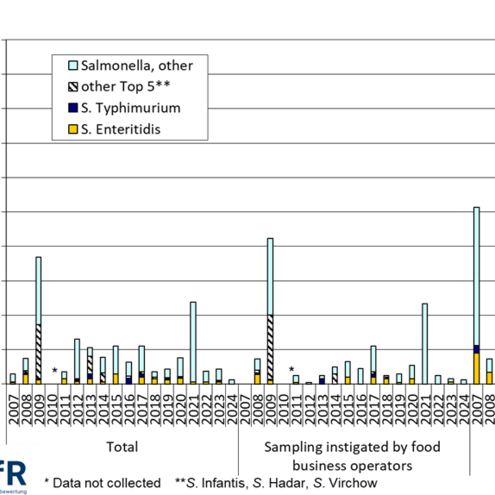
As part of the investigation of breeding poultry (Gallus gallus) during rearing, results were reported for a total of 213 (2023: 114) flocks examined. Most of the samples were taken at the initiative of the food business operator. In 2024, as in previous years, no Salmonella was detected in any flock. In 2017, Salmonella was found in a total of five flocks, with S. Typhimurium found in two flocks and S. Infantis in one flock. In the years prior to 2017, no positive Salmonella findings had been reported in any parent flock during the rearing phase.
2.2 Salmonella control programme in laying hens
A total of 6,605 (2023: 6,840) flocks were tested in 2024 in accordance with Regulation (EU) No 517/2011. Salmonella was detected in 99 flocks (1.5 %) (Table 2). This represented a deterioration in the situation compared with the figures for previous years (2023: 0.9 %; 2022: 1.3 %; 2021: 1.0 %). S. Enteritidis or S. Typhimurium were detected in the laying phase in 59 laying hen flocks (0.9 %) (2023: 34 flocks, 0.5 %; 2022: 59 flocks, 0.8 %; 2021: 48 flocks, 0.7 %). S. Enteritidis was detected in 41 (0.6 %; 2023 and 2022: 0.4 %) and S. Typhimurium in 18 (0.3 %; 2023: 0.1 %; 2022: 0.4 %) of the flocks examined. It is clear that in 2024 the detection rate of Salmonella was less favourable than in the previous year and that, in addition, the detection of the two serovars relevant for control, S. Typhimurium and S. Enteritidis, increased, reaching a similar level to that in 2022.
Table 2: Examination of laying hens (Gallus gallus) in accordance with Regulation (EC) No 517/2011 in 2024
| Number of flocks examined | Salmonella | S. Enteriditis | S. Typhimurium | S. Enteritidis / S. Typhimurium | |||||
| Positive | % | positive | % | positive | % | positive | % | ||
| Sampling (total) | 6,605 | 99 | 1.5 | 41 | 0.6 | 18 | 0.3 | 59 | 0.9 |
| Of which: sampling at the initiative of the food business operator | 6,583 | 49 | 0.7 | 15 | 0.2 | 9 | 0.1 | 24 | 0.4 |
Of which: sampling as part of official control Of which: Routine sampling as part of official control Of which: Suspected and follow-up investigations as part of official control | 3,456 | 65 | 1.9 | 29 | 0.8 | 10 | 0.3 | 39 | 1.1
|
| 3,404 | 47 | 1.4 | 15 | 0.4 | 7 | 0.2 | 22 | 0.6
| |
| 52 | 18 | 34.6 | 14 | 26.9 | 3 | 5.8 | 17 | 32.7 | |
As part of official control, Salmonella spp. was detected in 65 of the 3,456 laying flocks (1.9 %) in the laying phase in 2024. S. Enteritidis or S. Typhimurium was detected in 39 flocks (1.1 %). In 29 flocks (0.8 %), S. Enteritidis was detected, and in 10 flocks (0.3 %), S. Typhimurium was detected. In 2023, official control detected Salmonella spp. in 1.2 % (2022: 1.8 %) of laying hen flocks and S. Enteritidis or S. Typhimurium in 0.7 % (2022: 1.1 %) of flocks. This represents an overall increase in the detection rate of Salmonella in official control compared to the previous year. While the detection rate of S. Typhimurium rose slightly, that of S. Enteritidis increased more significantly compared to the previous year. As in previous years, S. Enteritidis was once again dominant. The shift towards S. Typhimurium observed in 2022 did not continue.
The detection rates in laying hen flocks during the laying phase from 2008 to 2024 for Salmonella spp. (sum of all serovars) and for the serovars S. Enteritidis and S. Typhimurium are summarised in Figure 2, separately for the different reasons for testing.
In 2024, official controls were carried out in 52 (2023: 67) flocks as suspected or follow-up investigations. Salmonella spp. was detected in 18 of these flocks (34.6 %; 2023: 16.4 %) (Table 2). These higher detection rates reflect the targeted risk-oriented testing.
During the examination of laying hens during rearing, Salmonella was detected in five of the 672 flocks examined (0.7 %; 2023: 0.3 %). In one flock, the serovar S. Typhimurium, which is relevant for control, was detected, and in four other flocks, serovars that are not relevant for control were detected. In 2023, two flocks (0.3 %) were reported to be positive. One flock was infected with the control-relevant serovar S. Enteritidis. The situation regarding Salmonella spp. has therefore deteriorated slightly compared to the previous year and is now at a similar level to 2022, when six positive flocks (0.8 %) were reported, including one with the serovar S. Enteritidis.
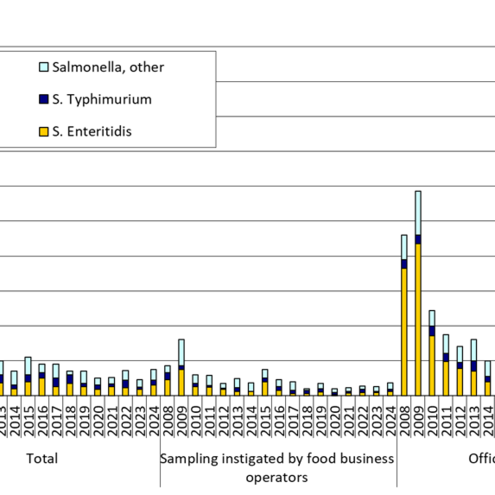
2.3 Salmonella control programme for broilers
A total of 20,393 (2023: 20,486) flocks were tested in 2024 in accordance with Regulation (EU) No 200/2012. Salmonella was detected in 271 flocks (1.3 %) (Table 3). In 2023, 1.0 % of the flocks tested were positive for Salmonella spp. The serovars S. Enteritidis or S. Typhimurium were detected in twelve flocks (0.06 %) in 2024 (2023: 6 flocks, 0.03 %). S. Enteritidis was detected in three (0.015 %) and S. Typhimurium in nine (0.04 %) of the flocks tested. In 2023, S. Enteritidis (2 flocks, 0.01 %) and S. Typhimurium (4 flocks, 0.02 %) were also detected (Figure 3). Thus, in 2024, the detection rate for Salmonella spp. and also for the serovars relevant for control measures increased compared to previous years, but did not reach the levels observed before 2021. The detection of S. Infantis continued to decline. While this serovar was still reported in 32 flocks in 2022, it was only detected in four flocks in 2024, as in 2023 (0.02 %; 2023: 0.02 %).
Looking at the detection rates separately for self-monitoring and official testing, differences in the development of Salmonella detection rates can be seen in each case (Figure 3).
Looking only at the officially tested flocks, eight (2.4 %) of the 340 flocks tested were found to be positive for Salmonella. In one of these flocks (0.3 %), the control-relevant serovar S. Typhimurium was detected. Compared to the previous year, the detection rate for Salmonella overall and for the control-relevant serovars increased in the official investigation in 2024 (2.4 % vs. 1.7 % in 2023), but did not reach the level of 2022 (2.6 %). In 2023, no serovars relevant for control were detected, whereas in 2022 both S. Enteritidis and S. Typhimurium had been detected.
Table 3: Testing of broilers (Gallus gallus) in accordance with Regulation (EC) No 200/2012 in 2024
| Number of flocks tested | Salmonella | S. Enteriditis | S. Typhimurium | S. Enteritidis / S. Typhimurium | ||||||
| Positive | % | positive | % | positive | % | positive | % | |||
| Sampling (total) | 20,393 | 271 | 1.3 | 3 | 0.015 | 9 | 0.04 | 12 | 0.06 | |
| Of which: sampling at the initiative of the food business operators | 20,393 | 266 | 1.3 | 3 | 0.015 | 9 | 0.04 | 12 | 0.06 | |
| Of which: sampling as part of official control | 340 | 8 | 2.4 | 0 | 0 | 1 | 0.3 | 1 | 0.3 | |
Figure 3
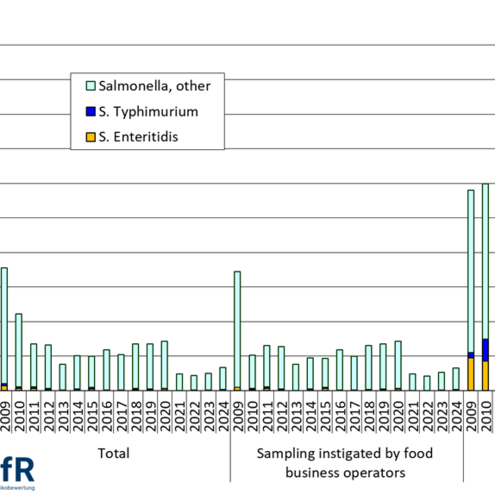
2.4 Salmonella control programme for breeding turkeys
A total of 96 (2023: 79) breeding turkey flocks were reported for testing in 2024 in accordance with Regulation (EC) No 1190/2012. Of these flocks, two flocks (2.1 %) tested positive for Salmonella in 2024 (Table 4). No control-relevant serovar was detected in either of the two flocks. In 2023, two positive flocks (2.5 %) were also reported. In one of these flocks (1.3 %), the control-relevant serovar S. Typhimurium was detected in 2023 (Figure 4). These positive flocks were identified during operational investigations.
Thus, a slight improvement in the situation was observed for Salmonella overall and for the control-relevant serovars.
As in 2023, 77 breeding flocks were examined as part of official control. Salmonella was not detected in any of these examinations.
During rearing, Salmonella was detected in only one of the 30 flocks tested. However, this was not a serovar relevant for control. In 2023, none of the 32 flocks tested were positive, while in 2022, two S. Typhimurium-positive flocks were detected.
Table 4: Examination of turkey breeding flocks in accordance with Regulation (EC) No 1190/2012 in 2024
| Number of flocks tested | Salmonella | S. Enteriditis | S. Typhimurium | S. Enteritidis / S. Typhimurium | |||||
| Positive | % | positive | % | positive | % | positive | % | ||
| Sampling (total) | 96 | 2 | 2.1 | 0 | 0 | 0 | 0 | 0 | 0 |
| Of which: sampling at the initiative of the food business operator | 92 | 2 | 2.2 | 0 | 0 | 0 | 0 | 0 | 0 |
| Of which: sampling as part of official control | 77 | 0 | 0 | 0 | 0 | 0 | 0 | 0 | 0 |
Figure 4
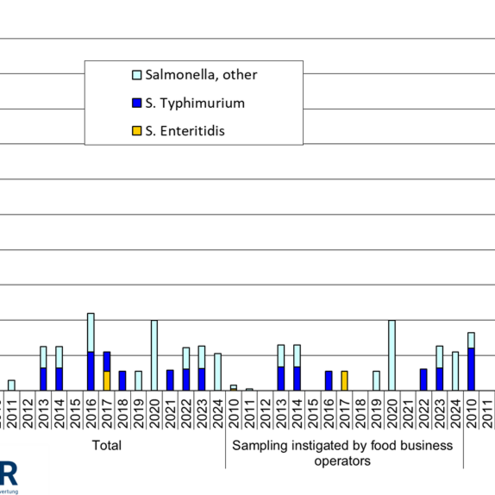
2.5 Salmonella control programme for fattening turkeys
A total of 4,220 (2023: 3,819) fattening turkey flocks were tested in accordance with Regulation (EU) No 1190/2012 (Table 5). Of these flocks, 23 (0.5 %) tested positive for Salmonella spp. In 2024, control-relevant serovars were detected in twelve flocks (0.3 %). Four flocks were infected with S. Enteritidis (0.1 %) and eight flocks with S. Typhimurium (0.2 %). In the previous year, 0.5 % of the fattening turkey flocks tested were also Salmonella-positive. Of the control-relevant serovars, S. Enteritidis (1 flock, 0.03 %) and S. Typhimurium (6 flocks, 0.2 %) were detected in 2023 (Figure 5). Thus, the favourable situation of recent years with regard to Salmonella continued in 2024, although the detection rate of serovars relevant for control was higher compared to the situation in 2023. More frequent detections were reported for both serovars in 2024.
Official investigations reported a slightly lower proportion of positive flocks than in most previous years (2.6 %; 2023: 3.2 %; 2022: 3.4 %; 2021: 5.0 %; 2020: 2.0 %; 2019: 4.3 %).
Table 5: Testing of fattening turkey flocks in accordance with Regulation (EC) No 1190/2012 in 2024
| Number of flocks examined | Salmonella | S. Enteriditis | S. Typhimurium | S. Enteritidis / S. Typhimurium | |||||
| Positive | % | positive | % | positive | % | positive | % | ||
| Sampling (total) | 4,220 | 23 | 0.5 | 4 | 0.1 | 8 | 0.2 | 12 | 0.3 |
| Of which: sampling at the initiative of the food business operator | 4,219 | 21 | 0.5 | 4 | 0.1 | 7 | 0.2 | 11 | 0.3 |
| Of which: sampling as part of official control | 151 | 4 | 2.6 | 2 | 1.3 | 1 | 0.7 | 3 | 2 |
Figure 5
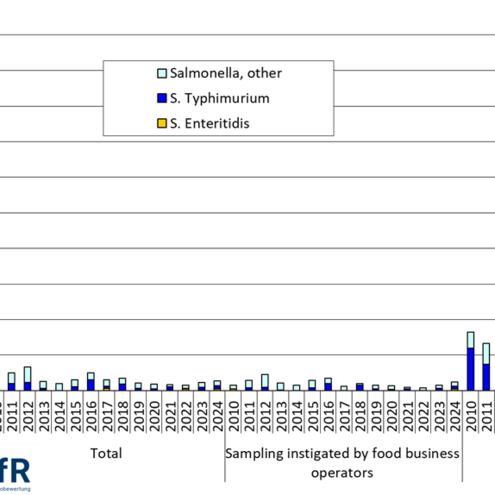
3 Summary
The results submitted by the federal states as part of the control programmes under Regulation (EC) No 2160/2003 were summarised at federal level for reporting purposes. They document a favourable situation for 2024 in terms of Salmonella prevalence in breeding chickens, breeding turkeys and fattening turkeys, as well as a slight unfavourable development in broilers and laying hens.
All target values were achieved. For breeding chickens, broilers, breeding turkeys and fattening turkeys, a prevalence of less than 1 % was achieved for the serovars relevant to control measures, while for laying hens the prevalence was 0.9 %, below the target value of 2 %.
Although no positive findings for the serovars relevant to control were recorded in 2024 in the flocks of breeding chickens and breeding turkeys examined, regular tests in previous years, including during rearing, showed that the serovars S. Enteritidis and S. Typhimurium can occur there and, if not detected in time, can be introduced into downstream production lines. The detection of S. Enteritidis and S. Typhimurium in laying hens, broilers and fattening turkeys requires continuous monitoring. In 2024, there were increased reports of S. Enteritidis and S. Typhimurium in all three animal species and types of use. In contrast, the detection of S. Infantis in broilers has continued to decline, and the serovar has not been detected in breeding chickens for several years. In broilers, this serovar is not one of the serovars relevant for control.
Salmonella was detected in 0.3 % of breeding chicken flocks in 2024. None of the flocks tested positive for a serovar relevant for control measures. The prevalence of Salmonella in laying hen flocks was 1.5 %. Of these flocks, 0.9 % tested positive for a serovar relevant for control measures. In broiler chickens, Salmonella was detected in 1.3 % of flocks, with a very low detection rate of 0.06 % for control-relevant serovars. In 2024, Salmonella was detected in 2.1 % (2 out of 96) of breeding turkey flocks. None of the flocks tested positive for a control-relevant serovar. In fattening turkey flocks, the prevalence of Salmonella was 0.5 % of flocks. A control-relevant serovar was detected in 0.3 % of flocks.
The situation for poultry is expected to remain stable in the coming years and the target values set should generally be achievable. To this end, it is important that the established procedures and efforts are continued on an ongoing basis.
Further information on Salmonella is available on the BfRshort forGerman Federal Institute for Risk Assessment website
- Salmonella topic page Go to page